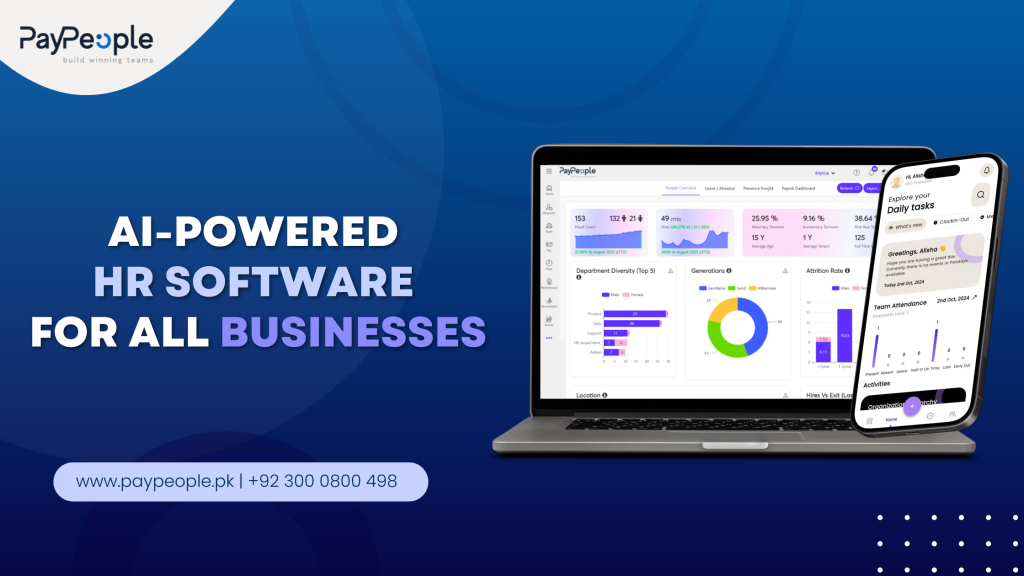Paypeople # 1 is one of the top Human Resources Policy plays a pivotal role in ensuring that organizations comply with labor laws and regulations. These policies provide a structured framework that governs employee behavior, outlines organizational expectations, and sets forth procedures to handle various employment-related issues. Ensuring compliance with labor laws through well-crafted HR policies not only protects organizations from legal liabilities but also fosters a fair and equitable workplace. This article explores how HR policies ensure compliance with labor laws, covering key components, implementation strategies, and best practices.
Click to Start Whatsapp Chat with Sales
Call #:+923000507555
Email: sales@Paypeople.pk
Paypeople # 1 Human Resources Policy

Understanding Labor Laws and Their Importance
Labor laws are designed to protect the rights of Human Resources Policy and regulate the relationship between employers and employees. They cover a wide range of areas, including:
- Employment Standards: Minimum wage, working hours, overtime pay, and rest periods.
- Health and Safety: Workplace safety standards and protocols.
- Anti-Discrimination: Equal employment opportunities and protection against workplace discrimination and harassment.
- Leave Policies: Entitlement to various types of leave, such as maternity leave, sick leave, and annual leave.
- Termination and Severance: Procedures for lawful termination and severance pay.
Key Components of HR Policies for Compliance
HR policies should be comprehensive and address all areas regulated by labor laws. Key components of HR policies that ensure compliance include:
Employment Standards
- Wages and Salaries: Policies must clearly outline the organization’s pay structure, ensuring compliance with minimum wage laws and timely payment of wages.
- Working Hours: Define standard working hours, overtime policies, and rest breaks in accordance with legal requirements.
- Overtime Pay: Ensure that overtime is compensated at the legally mandated rates and outline procedures for recording and approving overtime work.
Health and Safety
- Safety Protocols: Establish safety guidelines and protocols to comply with occupational health and safety regulations.
- Emergency Procedures: Provide clear instructions for emergency situations, including evacuation plans and first aid procedures.
- Training Programs: Include regular training sessions on workplace safety to ensure employees are aware of safety practices and regulations.
Anti-Discrimination and Harassment
- Equal Employment Opportunity: Ensure recruitment, promotion, and compensation practices are free from discrimination based on race, gender, age, disability, or other protected characteristics.
- Harassment Policies: Define what constitutes workplace harassment and outline procedures for reporting and addressing harassment complaints.
- Diversity and Inclusion: Promote a diverse and inclusive workplace through targeted policies and initiatives.
Leave Policies
- Maternity and Paternity Leave: Provide for maternity and paternity Human Resources Policy in compliance with national laws, including the duration and benefits associated with such leave.
- Sick Leave: Outline the conditions under which employees can take sick leave and the documentation required.
- Annual Leave: Ensure employees receive their statutory entitlement to annual leave and establish procedures for requesting and approving leave.

Termination and Severance
- Termination Procedures: Define lawful reasons for termination, notice periods, and documentation required for termination.
- Severance Pay: Outline the conditions under which severance pay is provided and how it is calculated.
- Disciplinary Actions: Establish a fair process for disciplinary actions and ensure it complies with labor laws.
Implementation Strategies for HR Policy Compliance
To effectively ensure compliance with labor laws through HR software in Pakistan, organizations must adopt strategic implementation practices. Key strategies include:
Legal Consultation
- Expert Advice: Engage legal experts to review HR policies and ensure they align with current labor laws and regulations.
- Regular Updates: Keep abreast of changes in labor laws and update policies accordingly to maintain compliance.
Employee Training and Awareness
- Policy Training: Conduct regular training sessions to educate employees about HR policies and their rights under labor laws.
- Communication: Use multiple channels (e.g., employee handbooks, intranet, meetings) to communicate HR policies clearly and consistently.
Documentation and Record-Keeping
- Accurate Records: Maintain accurate records of employee working hours, leave, wages, and disciplinary actions to demonstrate compliance with labor laws.
- Accessible Policies: Ensure that all HR policies are easily accessible to employees, either in print or digital format.
Monitoring and Auditing
- Internal Audits: Conduct regular internal audits to assess compliance with HR policies and labor laws.
- Compliance Checks: Implement compliance checks and controls to identify and rectify any deviations from established policies.
Reporting Mechanisms
- Complaint Procedures: Establish clear procedures for employees to report violations of labor laws or HR policies.
- Whistleblower Protection: Ensure employees who report violations are protected from retaliation.
Best Practices for HR Policy Compliance
Adopting best practices can enhance the effectiveness of HR policies in ensuring compliance with labor laws. Some best practices include:
Inclusive Policy Development
- Stakeholder Involvement: Involve key stakeholders, including legal advisors, HR professionals, and employee representatives, in the policy development process.
- Employee Feedback: Solicit feedback from employees on existing policies and potential areas for improvement.
Proactive Compliance Management
- Compliance Calendar: Develop a compliance calendar to track key dates and deadlines for regulatory filings and audits.
- Risk Assessment: Conduct regular risk assessments to identify potential areas of non-compliance and take corrective action.
Technology Integration
- HR Software: Use a Leave Management System to automate compliance-related tasks, such as tracking employee working hours, leave management, and payroll processing.
- Data Analytics: Leverage data analytics to monitor compliance trends and identify areas for improvement.
Continuous Improvement
- Policy Review: Regularly review and update HR policies to reflect changes in labor laws and organizational practices.
- Benchmarking: Benchmark against industry standards and best practices to ensure HR policies are effective and compliant.
Conclusion
HR policies are essential tools for ensuring compliance with labor laws. They provide a structured framework that governs various aspects of employment, from wages and working hours to health and safety, anti-discrimination, and termination procedures. By adopting strategic implementation practices and best practices, organizations can effectively develop and enforce HR policies that protect employee rights, minimize legal risks, and promote a fair and compliant workplace. Regular reviews and updates, coupled with employee training and robust monitoring systems, ensure that HR policies remain relevant and effective in addressing the evolving needs of both employees and the organization.
Click to Start Whatsapp Chat with Sales
Call #:+923000507555
Email: sales@Paypeople.pk
Human Resources Policy
Human Resources Policy
Human Resources Policy
We are one of the best How Human Resources Policy ensure compliance with labor laws? Price in Pakistan in Azad Kashmir, Bagh, Bhimber, khuiratta, Kotli, Mangla, Mirpur, Muzaffarabad, Plandri, Rawalakot, Punch, Balochistan, Amir Chah, Bazdar, Bela, Bellpat, Bagh, Burj, Chagai, Chah Sandan, Chakku, Chaman, Chhatr, updated on 2025-07-13T13:23:49+05:00 Dalbandin, Dera BugtiBarcode Shop offer lowest How Human Resources Policy ensure compliance with labor laws? Price Face Recognition in cities Dhana Sar, Diwana, Duki, Dushi, Duzab, Gajar, Gandava, Garhi Khairo, Garruck, Ghazluna, Girdan, Gulistan, Gwadar, Gwash, Hab Chauki, Hameedabad, Harnai, Hinglaj, Hoshab, Ispikan, Jhal, Jhal Jhao, Jhatpat, Jiwani, Kalandi, Kalat, Kamararod, Kanak, Kandi, Kanpur, Kapip, KapparWe can deliver Face Recognition in Karodi, Katuri, Kharan, Khuzdar, Kikki, updated on 2025-07-13T13:23:49+05:00 Kohan, Kohlu, Korak, Lahri, Lasbela, Liari, Loralai, Mach, Mand, Manguchar, Mashki Chah, Maslti, Mastung, Mekhtar, Merui, Mianez, Murgha Kibzai, Musa Khel Bazar, Nagha Kalat, Nal, Naseerabad, Nauroz Kalat, Nur Gamma, Nushki, Nuttal, Ormara, Palantuk, Panjgur, Pasni, Piharak, Pishin, Qamruddin Karez, Qila Abdullah, Qila Ladgasht and this was updated on 2025-07-13T13:23:49+05:00 We also deal with How Human Resources Policy ensure compliance with labor laws? Price in Qila Safed, Qila Saifullah, Quetta, Rakhni, Robat Thana, Rodkhan, Saindak, Sanjawi, Saruna, Shabaz Kalat, Shahpur, Sharam Jogizai, Shingar, Shorap, Sibi, Sonmiani, Spezand, Spintangi, Sui, Suntsar, Surab, Thalo, Tump, Turbat, Umarao, pirMahal, Uthal, Vitakri, Wadh, Washap, Wasjuk, Yakmach, Zhob, Federally Administered Northern Areas/FANAWe are already sent Face Recognition to these places – Astor, updated on 2025-07-13T13:23:49+05:00 Baramula, Hunza, Gilgit, Nagar, Skardu, Shangrila, Shandur, Federally Administered Tribal Areas/FATA, Bajaur, Hangu, Malakand, Miram Shah, Mohmand, Khyber, Kurram, North Waziristan, South Waziristan, Wana, NWFP, Abbottabad, Ayubia, Adezai, Banda Daud Shah, Bannu, Batagram, Birote, Buner, Chakdara, Charsadda, Chitral, Dargai, Darya Khan, Dera Ismail Khan and this was updated on 2025-07-13T13:23:49+05:00 we are planning to open a branch office of in Drasan, Drosh, Hangu, Haripur, Kalam, Karak, Khanaspur, Kohat, Kohistan, Lakki Marwat, Latamber, Lower Dir, Madyan, Malakand, Mansehra, Mardan, updated on 2025-07-13T13:23:49+05:00 Mastuj, Mongora, Nowshera, Paharpur, Peshawar, Saidu Sharif, Shangla, Sakesar, Swabi, Swat, Tangi, Tank, Thall, Tordher, Upper Dir, Punjab, Ahmedpur East, Ahmed Nager Chatha, Ali Pur, Arifwala, Attock, Basti Malook, BhagalchurFace Recognition in Bhalwal, Bahawalnagar, Bahawalpur, Bhaipheru, Bhakkar, Burewala, Chailianwala, Chakwal, Chichawatni, Chiniot, Chowk Azam, Chowk Sarwar Shaheed, Daska, Darya Khan, Dera Ghazi Khan, Derawar Fort, updated on 2025-07-13T13:23:49+05:00 Dhaular, Dina City, Dinga, Dipalpur, Faisalabad, Fateh Jang, Gadar, Ghakhar MandiFace Recognition How Human Resources Policy ensure compliance with labor laws? Price s Demands very high in Gujranwala, Gujrat, Gujar Khan, Hafizabad, Haroonabad, Hasilpur, Haveli Lakha, Jampur, Jhang, Jhelum, Kalabagh, Karor Lal Esan, Kasur, Kamalia, Kamokey, Khanewal, Khanpur, Kharian, Khushab, Kot Addu, Jahania, Jalla Araain, Jauharabad, Laar, Lahore, Lalamusa, Layyah, Lodhran, Mamoori, Mandi Bahauddin, Makhdoom Aali, Mandi Warburton, Mailsi, Mian Channu, Minawala, Mianwali, Multan, Murree, Muridke, Muzaffargarh, Narowal, Okara, Renala Khurd, Rajan Pur, Pak Pattan, Panjgur and this was updated on 2025-07-13T13:23:49+05:00 and current How Human Resources Policy ensure compliance with labor laws? Price of is Rs 100 in Pattoki, Pirmahal, Qila Didar Singh, Rabwah, Raiwind, Rajan Pur, Rahim Yar Khan, Rawalpindi, Rohri, Sadiqabad, Safdar Abad – (Dhaban Singh), Sahiwal, Sangla Hill, Samberial, Sarai Alamgir, Sargodha, Shakargarh, Shafqat Shaheed Chowk, Sheikhupura, Sialkot, Sohawa, Sooianwala, Sundar (city), Talagang, Tarbela, Takhtbai, Taxila, Toba Tek Singh, Vehari, Wah Cantonment, Wazirabad and this was updated on 2025-07-13T13:23:49+05:00 Software solutions are widely available with Price updated on 2025-07-13T13:23:49+05:00 in Sindh, Ali Bandar, Baden, Chachro, Dadu, Digri, Diplo, Dokri, Gadra, Ghanian, Ghauspur, Ghotki, Hala, Hyderabad, Islamkot, Jacobabad, Jamesabad, Jamshoro, Janghar, Jati (Mughalbhin), Jhudo, Jungshahi, Kandiaro, Lahore, Kashmor, Keti Bandar, Khairpur, updated on 2025-07-13T13:23:49+05:00 Khora, Klupro, Khokhropur, Korangi, Kotri, Kot Sarae, Larkana, Lund, Mathi, Matiari, Mehar, Mirpur Batoro, Mirpur Khas, Mirpur Sakro, updated on 2025-07-13T13:23:49+05:00 Mithi, MithaniThe Barcode Shop deliver high quality Face Recognition in updated on 2025-07-13T13:23:49+05:00 Moro, Nagar Parkar, Naushara, Naudero, Noushero Feroz, Nawabshah, Nazimabad, Naokot, Pendoo, Pokran, Qambar, Qazi Ahmad, Ranipur, Ratodero, Rohri, Saidu Sharif, Sakrand, Sanghar, Shadadkhot, Shahbandar, Shahdadpur, Shahpur Chakar, Shikarpur, Sujawal, Sukkur, Tando Adam, Tando Allahyar, Tando Bago, Tar Ahamd Rind, Thatta, Tujal, Umarkot, Veirwaro, Warah and this was updated on 2025-07-13T13:23:49+05:00
21-5-2024


